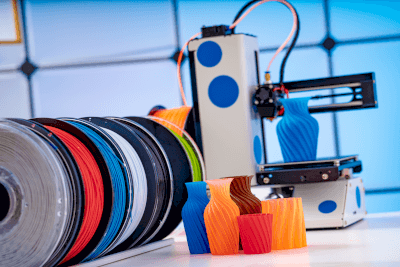What Is a Full Color 3D Printer?

A full-color 3D printer is a manufacturing machine that uses the inkjet method to create multi-colors when layering molding materials in a two-dimensional cross-sectional shape to create a three-dimensional model based on 3D data. By combining conventional thermal lamination and optical modeling technologies with color inkjet printer technology, it is possible to produce full-color models in thousands to millions of colors.
ABS resin and acrylic resin are used as molding materials. The advantage of this technology is that it does not require a mold, and coloring is done directly in the process of creating a three-dimensional model using color ink.
For example, rather than showing a photograph to explain a product, it is more powerful and persuasive to let the audience hold a real color 3D image in their hands.
Uses of Full-Color 3D Printers
Full-color 3D printers do not make a mold for manufacturing. Rather, they create a three-dimensional image directly by layering and curing thin layers of molding material little by little based on the 3D data of the object to be modeled. This enables prompt prototyping, shortening the development period, improving development efficiency, and reducing costs. It is especially suited for high-mix, low-volume production.
Low-cost, easy-to-operate tabletop products that specialize in small modeling products have also been introduced. These products are powerful in fostering creativity in school education, for example. The advantages are increased by using color. In addition, it is easy to examine designs, pursue colors, and check usability during product development by holding the actual product in one’s hand.
Principle of Full-Color 3D Printers
There are several types of 3D printer principles, but in particular, color can be achieved by combining the thermal melting and laminating method and the optical molding method with inkjet, which is the principle of full-color 3D printers. In this method, ink of each color is ejected from multiple ink nozzles to add color to a thin layer of modeling material.
The thermal melting and stacking method is a modeling method in which thermally melted modeling material is extruded through nozzles, stacked, and cooled. The 3D data of the modeling object is used to create the desired shape. Materials such as PLA (polylactic acid), ABS, PC (polycarbonate), and nylon can be used as thermoplastic resin. Materials that can absorb color inks are required. Color ink is injected using color inkjet printer technology.
In the optical molding method, the resin is solidified one layer at a time by irradiating the molding material extruded from the nozzle with a UV laser. The surface is characterized by smoothness and high definition, and photo-curable epoxy resins and acrylic resins are used as molding materials. Color inks are also made from acrylic resins and light-cured to ensure strength.